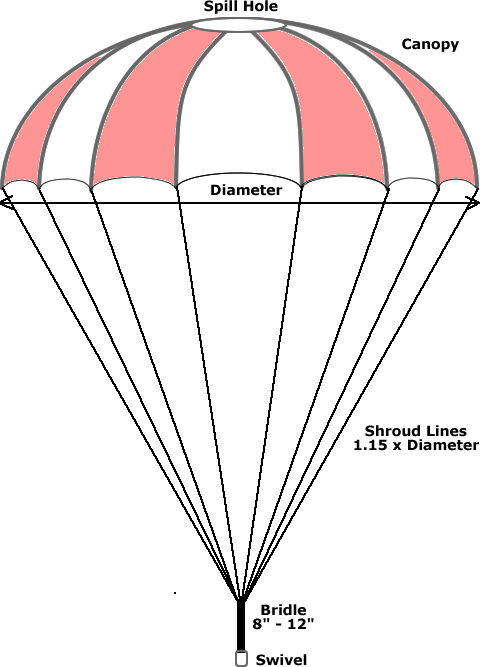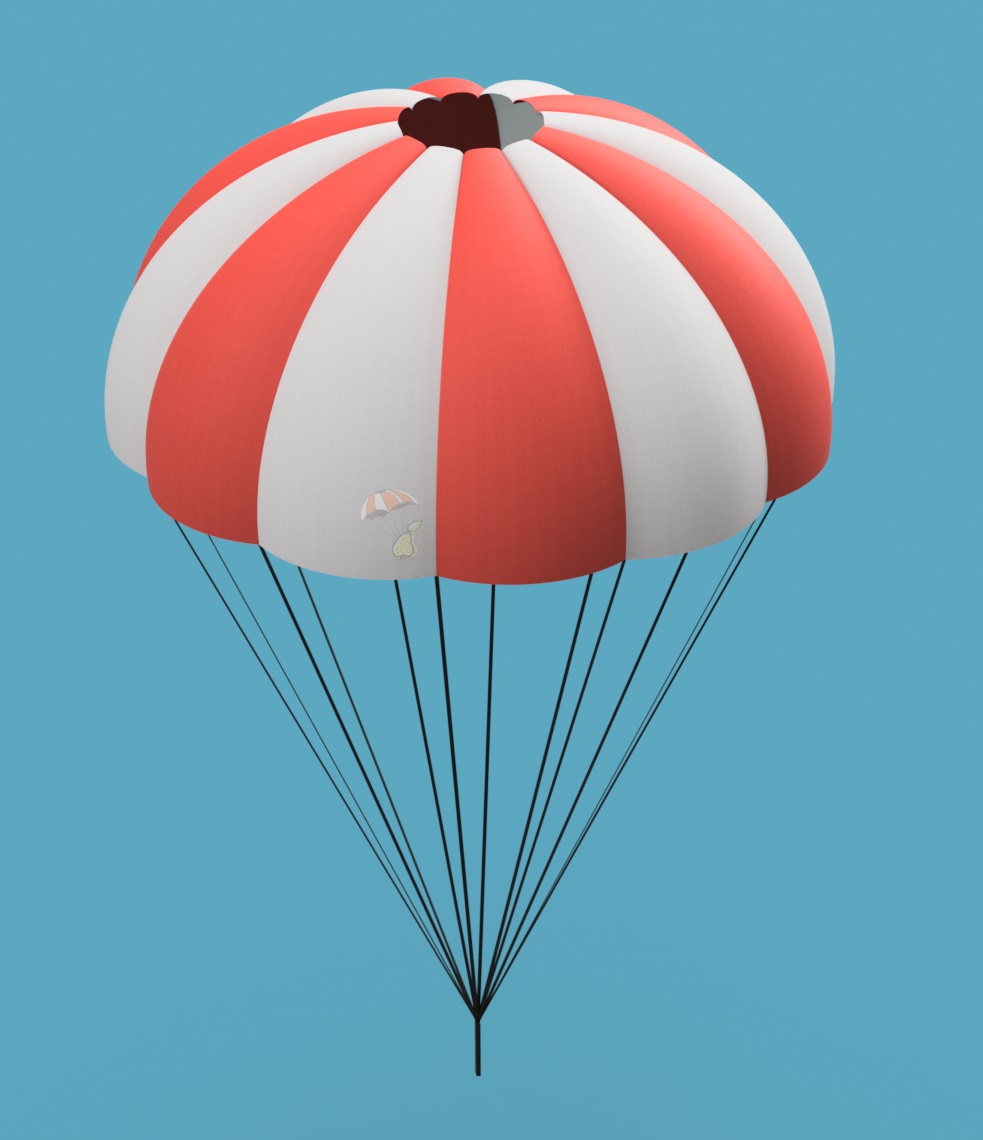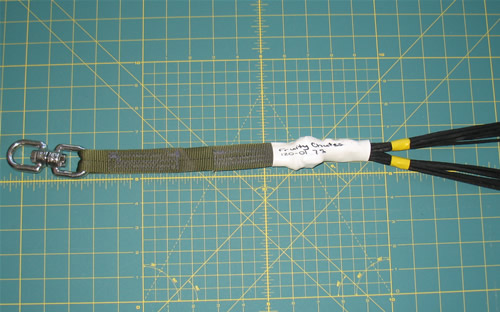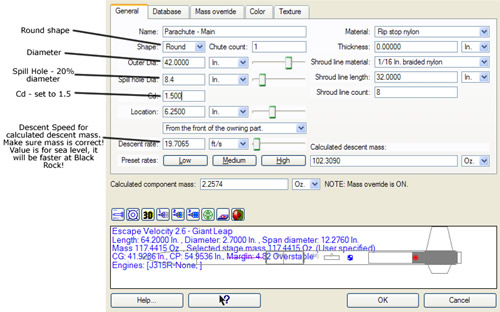Next: Parachute Tutorials
How to Make a Parachute
Classic Fruity Chutes have the classic ellipsoid shape of many military parachutes. The shape is similar to a hemisphere, but the top is flattened. This has the same drag coefficient as a hemispherical design but reduces the amount of material and lowers the weight. This design has several advantages over other designs:
- The shape has the theoretical maximum drag coefficient of 1.5 for vertical descent.
- Uses the least amount of material for a given canopy size and load capability.
- Has the lightest weight per load capacity.
- Packs into a small volume.
Our new Iris Ultra parachutes feature a pull down apex design resulting in even higher efficiency. This allows a smaller parachute to do the same work as a larger parachute.
Overall Design
The drawing below shows the major components of the parachute and relative dimensions.
IMPORTANT: Fruity Chutes diameter is the actual opening size of the parachute, not the distance across the top of the canopy!


CFC-36 Top View

CFC-36 Ground View
Canopy
The Canopy consists of multiple gores shaped so that, when sewn together, it forms the ellipsoid shape. The seams used are called a "Flat Felled" seam which has the advantage of being double stitched and having four layers of material. As a result, the seams are much stronger than the material.
As the parachute size goes up, the number of gores increases. This allows for more connection points to the parachute and keeps the load capability per shroud line more constant. Small parachutes have just 8 gores, while our 192" parachute has 18.
The material used is 1.1oz calendared rip stop and meets Mil Spec PIA-C 44378 Type IV specification. This is a process where the nylon is rolled under heat and high pressure to lower the porosity of the nylon without the need for coatings. The result is a very strong, lightweight fabric with low permeability. If you get a hole or tear in the rip stop, it does not spread.
Spill Hole
Our standard design comes with a spill hole that is 20% of the diameter of the canopy. It is just 3% of the area. A spill hole further increases the stability of the parachute and prevents it from "puffing". The spill hole is reinforced with bias tape to ensure maximum strength. Large parachutes also come standard with a deployment parachute connection loop sewed onto the bias tape reinforcement.
Shroud Lines & Canopy Connection
We have five types of shroud line depending on the size and type of parachute:
200# Nylon Paraline - MIL-C 5040 certified Type IIA 200 lb break - This is used in the CFC-12 to CFC-30 standard elliptical parachutes, and top lines on the IFC-36 to IFC-192 Iris Standard parachutes.
400# Nylon Paraline - Type IIIA 400# Break - This is used on the CFC-36 to CFC-120, and IFC-36 to IFC-192 main lines.
200# Spectra Picoline - PIA -C-1200 certified 200 Lb break - This is used on the IFC-30-S to IFC-36-S, IFC-30-SL to IFC-42-SL, the IFC-30-SUL to IFC-120-SUL.
400# Spectra Nanoline - PIA -C-1200 certified 400 Lb break - This is used on the IFC-48-S to IFC-240-S.
725# Spectra Microline - PIA -C-1200 certified 725 Lb break - This is an option for the IFC-144-SP to IFC-240-SPR.
The connection to the canopy is sized to the parachute. The connection to the canopy is triple stitched for maximum strength directly to the parachute seam using Grosegrain tape reinforcement. Standard shroud length is 115% of the canopy diameter.

The shroud connection pattern we use is called a "hand bag" closure. Rather than each shroud line connecting as a simple loop to the seam next to it, the lines connect from one side of the parachute to the other. If you picture the parachute being folded like a taco, the shroud lines connect from the seam on one side to the seam on the other side. This lets the lines be more easily untangled if the bridle slips through the lines. You can also easily undo the bridle and untangle the lines. Please email us if you want some tips on how to do this.
Bridle
Fruity Chutes parachutes come standard with all the shroud lines connected to a high-strength bridle. The bridle is constructed using nylon webbing or Kevlar. All Kevlar used by Fruity Chutes is made to PIA -C-87129A standards. The standard parachutes feature a swivel sewn onto the end. The strength of the materials is designed to allow for a shock of as much as 10x or more the descent rating of the parachute.

192" Standard Parachute Bridle. Note two bundles of shroud lines. One bundle to the left side of the parachute, the other bundle goes to the right side.
Modeling with RockSim
Analysis of descent rate over many flights using Fruity Chutes has verified that the Cd of Fruity Chutes is 1.5 for Elliptical or 2.2 for Iris Ultra, which is very close to the theoretical maximum for parachutes. You can closely predict your descent speed within 10% or better using RockSim by setting your Cd to this value. See the screen shot below for how to properly model a Fruity Chute.

Remember, this descent speed is for sea level. It will increase as elevation increases.
Descent Rate Calculator - Use this handy online tool to precisely calculate the performance for any Fruity Chute.
Next: Parachute Tutorials
